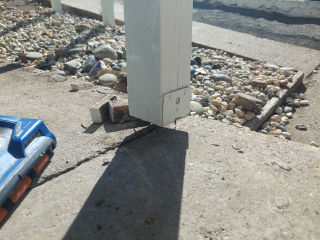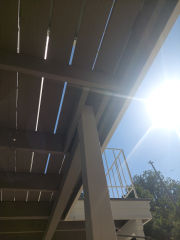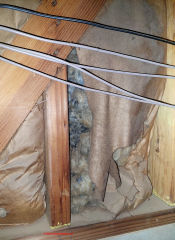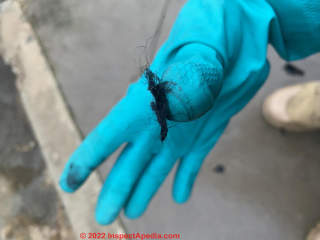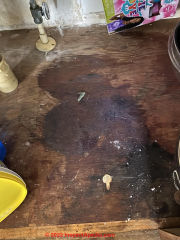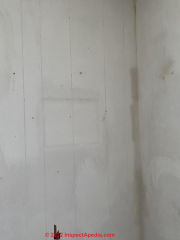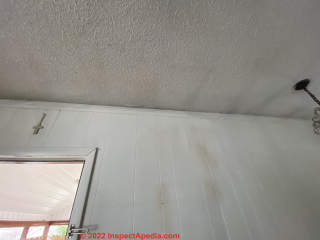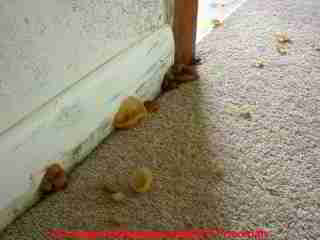 Hazard Reduction for Unsafe Spaces
Hazard Reduction for Unsafe Spaces
Reduce hazards if you can't immediately leave a moldy or contaminated rental
- POST a QUESTION or COMMENT about this article topic
This article describes the legal responsibility of landlords and possible recourse for tenants when the rental space is unsafe and unsanitary - such as indoor air quality, mold, and sewage contamination.
When appropriate action is not taken by the landlord, and it is not possible for the tenant to move, we also discuss what can be done to reduce the level of danger. Various resources are included that may assist in the resolution of the housing problem.
InspectAPedia tolerates no conflicts of interest. We have no relationship with advertisers, products, or services discussed at this website.
- Daniel Friedman, Publisher/Editor/Author - See WHO ARE WE?
Steps to Reduce Indoor Mold, Sewage, or Similar Hazards
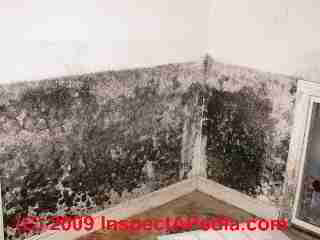 At IAQ EMERGENCY STEPS we give this advice:
At IAQ EMERGENCY STEPS we give this advice:
If you believe that an indoor air quality or contamination emergency exists, get out of the building and seek professional help from emergency services such as dialing 911 from a telephone outside of and away from the building.
The US EPA IAQ Wheel offers these emergency steps for immediate action in an actual or suspected mold or building air emergency [expanded with comments - Ed]:
- Immediately seek medical or public health assistance (e.g. from local or state health department -
suitable for mold and similar IAQ emergencies), [or in the case of carbon monoxide or other building gas hazards, or more broad building safety questions, your local fire department, emergency rescue services, or police department]. - Evacuate the affected areas,
if warranted, and if feasible, take steps to limit or stop unsafe conditions [turn off dangerous heating equipment, shut water mains where plumbing supply pipes have burst];
Watch Out: IF YOU SUSPECT CARBON MONOXIDE POISONING, GO INTO FRESH AIR IMMEDIATELY and get others out of the building, then call your fire department or emergency services for help.
Watch out: IF YOU SUSPECT SEWER GAS or METHANE GAS HAZARDS do not operate electrical switches, cell phones, or light any flame - there may be an explosion hazard. Get others out of the building, then call your fire department or emergency services for help. Sewer gas contains methane gas (CH4) - a risk for an explosion hazard or even fatal asphyxiation.
Details area at METHANE & SEWER GAS HAZARDS - Ventilate the suspected areas:
when appropriate, such as for carbon monoxide poisoning [first turn off the suspected equipment] or chemical spills, ventilate the affected areas with large amounts of outside air (use temporary fans if needed). - Immediately inform building occupants
and parents of minors of the problem and maintain clear communications.
Warranty of Habitability of Rental Properties
When you rent an apartment or home, in nearly all jurisdictions, rental property law dictates (and a proper rental contract states) that the landlord must provide safe, sanitary housing, and that the landlord must make necessary repairs if the premises are not in fact safe and sanitary.
That's the law, referred to as the Warranty of Habitability. No matter what your rental contract states, or even if you are renting with no contract, a tenant can not waive the responsibility of the landlord to provide safe housing nor the requirement that the landlord make necessary repairs promptly.
If you have notified your landlord of serious health or safety hazards, both orally and in writing, and if the landlord refuses to act, then you should bring that complaint to your local housing code enforcement officer where you live. The housing authority should inspect the property and if they agree with you, they can require the landlord to make the necessary repairs or the landlord can face costly fines.
But what if you've contacted your housing authority though and are convinced that there are unsafe or unsanitary conditions but no one has agreed to take any action whatsoever?
You may need to ask for help from a third party - an independent or private building inspector or even simply a contractor or your doctor, to document that there are actually unhealthy and unsafe conditions. You may also need to document that the landlord has refused to make required repairs in a reasonable time.
Then what? Safest is to move out.
If you move out because a rental unit is un-livable and if the landlord sues you for rent once you've left, then the Warranty of Habitability law can protect you, provided you can show the judge or court adequate proof of un-livability
Here is an example using rental property law from Wisconsin:
Wis. Stat. 704.07(4): If the premises become untenantable because of damage by fire, water ...or because of any condition hazardous to health,
... the tenant may remove from the premises unless the landlord proceeds promptly to repair or rebuild or eliminate the health hazard
... or the tenant may remove if the inconvenience to the tenant by reason of the nature and period of repair, rebuilding or elimination would impose undue hardship on the tenant....If the tenant justifiably moves out under this subsection, the tenant is not liable for rent after the premises become untenantable and the landlord must repay any rent paid in advance apportioned to the period after the premises become untenantable.
But if you cannot move out for valid reasons such as lack of housing or housing assistance and your own limited financial means, then what can you do?
If you cannot get out of an unsafe building
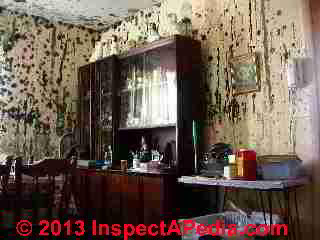 Watch out: First, if you smell gas or carbon monoxide or see smoke (or fire) YOU MUST GO OUTSIDE and call 911.
Watch out: First, if you smell gas or carbon monoxide or see smoke (or fire) YOU MUST GO OUTSIDE and call 911.
Staying in such a building is an immediate risk of death for its occupants. Get everyone out.
For other building hazards such as poor air quality, odors, mold contamination, possible sewage contamination, those areas may also be unsafe to occupy.
The U.S. EPA suggests that renters should report all plumbing leaks and moisture problems immediately to your building owner, manager, or superintendent.
In cases where persistent water problems are not addressed, you may want to contact local, state, or federal health or housing authorities.
However, some readers tell us that even in those unsafe conditions and even if they are already sick and think the building is the cause, they cannot leave because there is no emergency housing or no emergency money immediately available.
And some readers tell us - as you'll read below - that local health authorities and emergency housing authorities have been notified but have been unable to offer any assistance.
For that situation, and recognizing that staying in such a building can lead to very serious illness, injury or even death, we're forced by that situation to try to offer some advice, found here, with help from InspectApedia readers.
Really? It's uncommon to even try to give advice to people who, for any reason, are unable to get out of an unsafe, mold-contaminated environment, but in consideration of the situation you describe, and while "getting out" is the right thing to do, on this page we collected suggestions from various sources to try to address people in this situation:
- you don't own the building or apartment
- you believe, or know that there is a serious mold or similar indoor air quality problem that may in fact be dangerous to health
- you are unable to move elsewhere immediately
- your finances are very limited - going to a hotel or motel or other temporary housing isn't possible
- you have notified the building management, owners, and local, state, or federal health or housing authorities but have not received any help or advice
- you have discussed and addressed your health concerns with your doctor or with a local hospital emergency room physician.
See also
RENTERS & TENANTS ADVICE for UNSAFE or UNHEALTHY HOME
For other less immediate hazards - that is, the building is not on fire, setting off carbon monoxide detectors or smoke alarms, and is not collapsing, but where there are other unsafe conditions, notify the building owner and property managers immediately, both orally and in writing.
Keep in mind that sometimes a little public exposure of unsafe and improper conditions will help spur a property owner to get going on making their property safe and habitable.
If you would like to name your location - landlord, rental property, city, county, state - and post some photos of your conditions, that may help your cause. (You can only post one photo per comment, but as many comments and thus photos as you wish.)
Question: our apartment is contaminated with sewage, mold & other hazards, makes us sick, but we can't move out
... I am looking for some kind of help. I am in a rental wife my wife and 2 teenage children in Colfax, CA. The building was built around 1964 and it is a 4-plex. I have been sick for almost the whole time we've been here (2.5 years) so much so that I cannot work anymore.
So far I seem to be affected more than the rest of the family but we are all experiencing problems. In common are headaches, sensitivity to light, skin infections and so on. Myself I have chronic chest pain and struggle to breathe. I have been to the hospital so many times that I've given up on my life.
My wife is doing her best to keep us afloat but we can't afford to move. Not being able to work we can't afford to have any testing done. Needless to say we meet the criteria for disabled and low-income. That being said back to the building.
There is visible black mold and visible water damage. Almost non existent ventilation and recently found out that everyone's (4 plex) has been draining under my unit and the neighbors.
The crawl space or basement is separated by nothing but old particle board and 2x6s. No moisture barriers or insulation.
I informed property management and the city inspector as well as filing a complaint with the county and even CA dept. of public health. It's truly scary how each one tells me to contact another. Still have no help.
My mother and uncle both passed away in this unit 6 months apart. We've lost 5 pets to kidney failure and so on.
The water leaves an oily substance on everything and dehydrates people more than it should.
The building truly is the definition of Sick. I am reaching out to try to find out what is making my family sick before it kills us too. Yes that truly is feces. In the lower pictures. - Anonymous by private email 2022/08/16
Moderator reply: warn everyone of immediate hazards, get out of unsafe environment
Watch out: a deck or porch that is not properly-supported can collapse, injuring or killing anyone on or below that structure. Be sure that you've warned the occupants of that upper apartment and be sure that they and you have notified the building owner, landlord, property manager, in writing, that the structure is unsafe and could result in serious injury or worse.
I know it's a heck of a lot easier for me to say than for you to do, but given your description, I'd move heaven and earth to get everyone out of that apartment.
If nobody in the city is going to help you and the landlord isn't responding, and given that you're already of the opinion that the building is risking health and maybe even worse, life, you could find a legal aid lawyer who helps low-income people, but while you're litigating and staying in the property, you're quite possibly increasing the health risk to everyone.
If I were certain that the building is an immediate and serious health hazard, I'd get out immediately, even if it meant emergency housing. And in moving my belongings, I'd clean everything possible before moving it into new quarters.
Reader follow-up: facing homelessness
Yes Sir that's where I am at as far as leaving. Unfortunately my family has been homeless before and will not consider leaving even though they are dealing with similar issues as are my neighbors. I'm actually trying to get evicted at this point. There's no doubt it's toxic. Thanks anyway
Also just for a what not to do for the readers. This is a load bearing post for the upstairs units. Thanks again
Moderator reply: local help for emergency housing
I'm sure sorry but honestly from what I've seen, being forced to stay in a seriously contaminated environment can cause people to become hypersensitive and very sick.
Did you find any Colfax CA homeless or legal aid assistance agencies where you live?
- Housing vouchers: https://www.placer.ca.gov/2134/Housing-Vouchers
Placer County Housing Authority, P.O. Box 5346, Auburn, CA 95603
Email Placer County Housing Authority: pcha@placer.ca.gov
Phone: 530-889-7676, TDD: 800-735-2929
Possible shelter:
- Hospitality House (707) 961-1150, Grass Valley, CA 11.99 miles outside Colfax, California P.O. Box 2168, Fort Bragg, CA - 95437
Emergency Section 8 Housing
How do I apply for emergency Section 8 in California?
To apply for either type of help, visit your local Public Housing Agency (PHA).
For questions about HUD rental programs, including Housing Choice (Section 8) Vouchers, contact our Public and Indian Housing (PIH) Resource Center: Email us. Call toll-free (800) 955-2232.
Reader follow-up: no government nor legal aid sources are helpful, no Section 8 Housing
Yes Sir and I've left messages and filed complaints all the way up to the DOJ "Housing strike force" whom advertises they are in place for just this kind of situation.
Legal aide is overwhelmed and Attorneys do not want to touch anything housing related because of the COVID regulations and this being California. I understand I'm screwed.
I've actually had a person tell me that I should be lucky that my rent is cheap for the area and square footage after trying to get help from a county agency.
Section 8 is 2 years minimum wait . Anyway thanks again hopefully maybe someday I can reach out and tell you it was resolved. Thanks for the informative site. I refer to it frequently.
Moderator Reply: can't move-out: take steps to reduce immediate hazards where you are
Wow, sorry to hear all that but not surprised.
If you are not moving out, we might discuss what can be done to reduce the level of danger ... incomplete but better than nothing.
First of all: Document everything you do to try and resolve the issues present in your housing. Be sure to keep a record and your own copy of:
- Every phone call you make, the agency, the date, the person you talk to, and what you were told.
- Relevant medical records that document illness, disability, and treatment, as well as notes and recommendations from your doctor.
- Any written documentation submitted, whether it be a letter or form or application for services.
Reader follow-up:
I am open to all suggestions at the moment. I got the family out for the day and I just got home from the hospital but I'm running around trying to patch or seal every gap or crack. Haha sorry I'm communicating as if we were speaking in person
but the haha was because my neighbor just turned on their clothes dryer which vents under the units hence blowing said dust and debris (feces) right in through my windows. I truly have lost my mind to still be in this state. As before any suggestions would be wonderful.
Moderator Reply - Coping Steps to reduce indoor airborne hazards
A: Improve Indoor Air Quality
#1 - if weather permits, increase fresh air ventilation - lots of outdoor air can dilute indoor airborne contaminants.
#2 - if you wear a HEPA rated mask or even a simple n95 mask as much as possible, that reduces significantly the level of contaminant particles that you breathe in. It also is diagnostic. If you feel better after you've been wearing the mask for a while, that may tell you that there's definitely something in the air.
#3 - don't touch mold and then put your finger in your eye nor in a cut.
#4 - any moldy stuff that you can simply throw out is worth throwing out immediately.
Remember that I am talking in generalities and basically Flying Blind because I don't know anything about your building or where the problems are or how air moves in the building.
B: Cover Moldy or Sewage-Contaminated Surfaces
Besides my earlier list of priorities of steps to take to try to reduce IAQ/pathogen/mold hazards when you can't get out of a questionable apartment, we'll move on to what you can do to shelter moldy surfaces and reduce mold growth.
If you have large areas of visible mold, more than 30 sq.ft. of contiguous mold, then you shouldn't try removing or cleaning it yourself - as it deserves a cleanup professional.
But I've had some success by covering moldy bookcases or moldy walls by using masking tape to hold up simple thin plastic sheeting.
Normally I'd also say keep down the indoor humidity to reduce mold growth but it's a bit more tricky than that.
I've found that if there is already heavy mold growth on large areas of surfaces, depending on the mold genera/species that are dominant, a drop in humidity can result in a temporary (but dangerous) increase in release of airborne mold spores in that space. That's why I might prefer to cover those surfaces.
Similarly, put down 4-mil or better, 6-mil plastic over sewage spills on floors in crawl spaces.
If you have carpeted floors that are suspect, you can cover the flooring with plastic, too, but as that creates a slip and fall hazard you may need to put rugs, carpet strips, or even simple drop cloths over that surface to make walking a bit more safe.
C: Some Indoor Hazards are Easier to Avoid or Reduce
Some indoor hazards like those listed below are also serious but may be easier to reduce than gases or airborne mold.
- Asbestos -
suspect materials such as pipe insulation: don't disturb the insulation, and if some has fallen into an occupied space, damp wipe it up but do NOT try to vacuum that debris with an ordinary household vacuum cleaner or you may increase the airborne asbestos hazard. HEPA-rated vacuum cleaners may be fine.
See ASBESTOS PHOTO GUIDE to MATERIALS - Lead hazards
such as lead paint: don't disturb lead paint, damp wipe and vacuum up fallen debris, preferably with a HEPA rated vacuum cleaner.
See LEAD POISONING HAZARDS GUIDE - home
D: Consult Local Charities and Legal Aid Again?
If you've contacted the appropriate building and health authorities and housing authorities and are told that no help is available, you might consider looking for local charities or legal aid societies who can offer money or legal counsel that might help you negotiate with your local government, health, or other officials.
For example, in Colfax CA, the Justia website of lawyers
at https://www.justia.com/lawyers/california/colfax/legal-aid-and-pro-bono-services
lists possible legal aid and pro-bono (no fee) legal services in your area.
There you'll find legal aid available across many topics, including
- Personal Injury
- Civil Rights
- Domestic violence
- Foreclosure defense
- Elder Law
- Health Care Law
- Landlord Tenant disputes
For other readers, Justia's legal aid and pro-bono resource is organized by U.S. state or cities or counties within state, beginning at
https://www.justia.com/lawyers
And by searching the national Legal Services Corporation website, https://www.lsc.gov/about-lsc/what-legal-aid/get-legal-help, I find the following contact information for your area:
Legal Services of Northern California, Inc., For legal help, call (916) 551-2150, Website: https://www.lsnc.net, Fax: (916) 551-2195
See also LEGAL AID ATTORNEY HELP SOURCES
Constructive Eviction?
Occurs when a landlord does not physically or legally evict a tenant, but takes actions that interfere with the tenant's use and enjoyment of the premises significantly.
Constructive eviction can occur as a result of the landlord's breach of the implied covenant of quiet enjoyment if
(1) the landlord substantially interferes with the tenant's use and enjoyment of the premises by his actions or failure to act to resolve a problem;
(2) the tenant gives the landlord notice of the problem and the landlord fails to respond and resolve the problem; and
(3) the tenant vacates the premises in a reasonable amount of time after the landlord fails to resolve the problem. - Cornell Law School, Legal Information Institute, retrieved 2022/08/17, original source: https://www.law.cornell.edu/wex/constructive_eviction
Reader follow-up: immediate concern with sewage contamination a 4 Colfax ave apt. F Colfax, CA 95713.
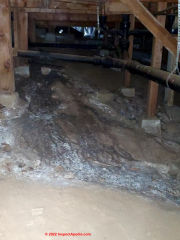 My apologies for not responding sooner but I had to take back my rental car that has been doubling as my bedroom/office.
My apologies for not responding sooner but I had to take back my rental car that has been doubling as my bedroom/office.
Thank you for all of the suggestions and the ones I haven't tried yet I'll be sure to.
At this point I am mostly concerned that it is more an issue of the sewage leak that occurred under the unit.
I'm going to send some pics to you for use if you'd like but your opinion would be greatly appreciated.
I apologize if they come through randomly as I'm working with my phone and can't compile a folder.
The property-owner is Deb's Property Management.
Moderator reply: Addressing sewage spill in crawl space
Our outline for dealing with sewage contaminated crawl spaces begins
You'll see that the very minimum to do would be to
- fix the sewage leak
- put down plastic ground cover over the soil to reduce movement of moisture and pathogen-contaminated dust up into the occupied space
If the sewage leak is ongoing, really I can't think that any remediation such as cleanup or even just putting down plastic would be useful because new sewage will simply fall atop the plastic sheeting.
Watch out: entering a crawl space where there is sewage contamination is dangerous, risking respiratory or other serious infection. Don't go into such an area without proper training and protective gear.
Even working in such an area, such as for the plumber who may be called on to fix the leak, is dangerous if proper protective clothing, respirator, etc. are not worn.
Use Fans to Exhaust a Crawl Space & to Send Fresh Clean Outdoor Air in Upstairs?
As a temporary measure, to reduce the sewage hazard of pathogens and gases entering the occupied space, two or more fans could be helpful as I'll describe here.
IF there is a crawl space opening into which someone could install a box fan blowing OUT, it may be possible to reduce the hazard to occupants in the space above.
By blowing air OUT of the contaminated crawl area, that can create a small negative air pressure with respect to the occupied space above, thus reducing the movement of sewer gases, odors, and pathogens (viruses, bacteria) that may ride on small dust particles that can enter the living space.
Ideally, we'd blow air OUT of the crawl space but NOT to a space right under an open building window (if there is a window nearby keep it shut),
and we might, at the same time, use one or more box fans to blow fresh clean outdoor air into the occupied space upstairs - using fans blowing air in from other sides of the building than the one with the crawlspace is being vented out.
Sewage & Mold-Contaminated Insulation
Insulation that looks as if has been wet and moldy, particularly if it's exposed to the sewage contaminated crawl space, will need to be removed completely, disposed of, and the exposed surfaces disinfected as part of a proper sewage-contaminated crawlspace remediation.
Tenants Rights & Unhealthy or Unsafe Properties: Resources
- BC, Garis, Len, & Clare, Joseph, Ph.D., RESPONDING TO UNHEALTHY PROPERTIES: DEVELOPING A
CENTRALIZED, CONSISTENT PROCESS FOR COMMUNITY SAFETY [PDF] (2011) Surrey, BC, Canada, - retrieved 2022/08/17 original source: https://www.surrey.ca/sites/default/files/media/documents/RespondingtoUnhealthyProperties.pdf
Excerpt:
As the situation currently stands in BC, potential property purchasers, lessees, and renters are unable to make informed decisions about the likelihood that prospective properties pose health and safety risks as a result of previous inappropriate use of the structure. - CA, CALIFORNIA TENANTS, A GUIDE TO RESIDENTIAL TENANTS’ AND LANDLORDS’ RIGHTS AND RESPONSIBILITIES [PDF] - retrieved 2022/08/17, original source: https://www.courts.ca.gov/documents/California-Tenants-Guide.pdf
- Consumer Financial Protection Bureau, offering a state-by-state listing of free legal aid programs, https://www.consumerfinance.gov/ask-cfpb/how-do-i-find-an-attorney-in-my-state-en-1549/
- CT, CONNECTICUT LANDLORDS & TENANTS RIGHTS & RESPONSIBILITIES [PDF] - retrieved 2022/08/17, https://www.jud.ct.gov/publications/hm031.pdf
- HUD, BAD LANDLORDS in FEDERAL HOUSING - COMPLAINTS - retrieved 2022/08/17, https://www.hud.gov/complaints/badlandlord - quoted in entirety below:
Hundreds of landlords have been fined and/or debarred from doing business with the federal government as a result of failing to provide safe and decent housing for the poor, while enriching themselves on taxpayer-funded subsidies.
Tenants have been forced to live in terrible housing, and neighborhoods have suffered from housing eyesores.
HUD calls this a double crime: one against both tenants and taxpayers.
To report a bad landlord to the Multifamily Housing Complaint Line call toll-free at (800) MULTI-70 (800) 685-8470) / TTY (800) 432-2209. - HUD, HCV HOMEOWNERSHIP PROGRAM [PDF] - retrieved 2022/08/17, https://www.hud.gov/program_offices/public_indian_housing/programs/hcv/homeownership
- LawHelp, Helping you find solutions to legal problems, https://www.lawhelp.org/find-help/
- LSC Legal Services Corporation, offers financial support for civil legal aid to low-income Americans. Use this web page (March 2023) to search for legal aid where you live:
https://www.lsc.gov/about-lsc/what-legal-aid/get-legal-help - NY, UPSTATE NEW YORK BUILDING ISSUES & MANTENANCE, LANDLORDS & TENANTS [PDF] - retrieved 2022/08/17, https://www.ithacatu.org/rights
- NY, Schneiderman, Eric T., Attorney General of New York, TENANT'S RIGHTS GUIDE - NEW YORK STATE [PDF], retrieved 2017/01/18, original source: ag.ny.gov/sites/default/files/pdfs/publications/Tenants_Rights.pdf
- USA.gov, provides resources to help find a lawyer and affordable legal aid, https://www.usa.gov/legal-aid
...
Reader Comments, Questions & Answers About The Article Above
Below you will find questions and answers previously posted on this page at its page bottom reader comment box.
Reader Q&A - also see RECOMMENDED ARTICLES & FAQs
On 2022-12-07 by InspectApedia (Editor)
@Cristie Rumfelt,
I mentioned earlier that you should be SURE to RULE OUT IMMEDIATE LIFE SAFETY HAZARDS such as an improperly-operating heating system - gas or oil fired in particular.
Be sure you have working CO detectors and smoke detectors.
Then ask your doctor if your medical complaints could be caused by or aggravated by conditions in your home and if so, what else you should be checking.
Keep us posted.
On 2022-12-07 by InspectApedia (Editor)
@Cristie Rumfelt,
That looks like fibers from a synthetic fabric.
I'd like to see a photo of the same material in each of those places where you said it's appearing. Look closely so that we can see if it is actually the same substance.
On 2022-12-07 by Cristie Rumfelt
This came off ceiling fans and something spidery legs is growing out of every socket and baseboard and where ceiling meets roof
On 2022-12-07 by InspectApedia (Editor)
@Cristie Rumfelt,
That looks as if a liquid, perhaps a liquid cleaner or soap product has spilled on the surface.
On 2022-12-07 by Cristie Rumfelt
I just found this under sink it has an oily look and it’s in a circle shape
On 2022-12-07 by InspectApedia (Editor)
@Cristie,
In your photos, I'm not sure which substance or surface or stain is the subject of your post or question.
If this is a damp area or has suffered water leakage there may be some mold growth on painted surfaces.
But to be safe, as we're seeing dark areas that could be soot staining on walls, you want to take special note of the condition of the building's heating system: if it is fueled by oil the burner may need cleaning / adjustment, and if it's gas fueled a check for sooty operation is important to avoid a dangerous carbon monoxide hazard.
If you make sure that you have properly located, installed, tested smoke detectors and carbon monoxide detectors you've taken a first critical step for the safety of yourself and others in the building.
The stains in the corner and on what looks like painted wood paneling may indeed be caused by moisture, leaks in the wall or condensation on it, possibly inviting mold growth. Have you
- tried cleaning those surfaces?
- had the building inspected for leaks or abnormal moisture levels?
If not I suggest that step.
On 2022-12-07 by Cristie
This has made me very sick and it turned my belongings black. The pictures don’t show how bad it is. It’s on every wall and some spots have orange spots
...
On 2022-12-07 by InspectApedia (Editor)
@Cristie,
Because the ceiling fan blades move through so much air, it's entirely common for any airborne contaminants and even simple house dust to collect as a grey-black sooty deposit on the fan blade edges.
On 2022-12-07 by Cristie Rumfelt
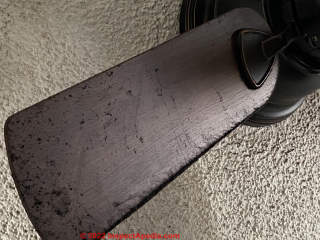 Good evening I am hopeful your would be able to help me in this horrific and that’s light compared to the events that happened due to this matter I am sending you some pictures of a residence I was rented on September 19 2022 I started having symptoms the first week and there was no visible signs of this upon moving in please help me
Good evening I am hopeful your would be able to help me in this horrific and that’s light compared to the events that happened due to this matter I am sending you some pictures of a residence I was rented on September 19 2022 I started having symptoms the first week and there was no visible signs of this upon moving in please help me
I would be forever grateful and if you are not able please point me in the right direction I’ve had testing done and have a pending report for finalization this Friday,symptoms include:
Confusion constant headache for the past 4 weeks psychosis severe fatigue numbness in right leg limbs heavy dizziness balance metal taste rash on face excessive ruination eye blurriness and irritation agitated memory loss pain in right side leg cramps yeast infection ringing in ear insomnia dont feel connected to myself slurred speech feel like
I’m going crazy delerius sad depressed my anxiety is much worse tremors feel scared loss of appetite swollen abdomen runny nose sneezing blood from nose right eye drooping loss of appetite irregular heartbeat extreme mood changes throat sore and burns coughing shortness of breath joint pain worse in morning
...
Continue reading at IAQ EMERGENCY STEPS, or select a topic from the closely-related articles below, or see the complete ARTICLE INDEX.
Or see these
Recommended Articles
- BUILDING SAFETY HAZARDS - home
- CARBON MONOXIDE - CO
- CRAWL SPACE SEWAGE CLEANUP
- DIRECTORY of MOLD / ENVIRONMENTAL EXPERTS
- DISINFECTANTS, SANITIZERS, FUNGICIDAL-SEALANTS SOURCES
- DUST SAMPLING PROCEDURE - inexpensive environtmental sample for testing
- FIBERGLASS HAZARDS
- FLOOD DAMAGE CLEANUP & REPAIR GUIDE - home
- HOUSING, EMERGENCY & TEMPORARY
- HOW MUCH SHOULD YOU PAY for professional inspection or testing services?
- INDOOR AIR QUALITY IMPROVEMENT GUIDE
- MOLD / ENVIRONMENTAL EXPERT, HIRE ? - when to hire an expert
- MOLD TESTING METHOD VALIDITY
- ODORS GASES SMELLS, DIAGNOSIS & CURE
- OTHER PEOPLE's MONEY - watch out for experts whose advice is principally designed to protect themselves at your expense
- RENTERS & TENANTS ADVICE for UNSAFE or UNHEALTHY HOME
- HEALTH DEPARTMENT HELP for RENTERS
- HIDDEN MOLD RISKS for RENTERS
- HOUSING, EMERGENCY & TEMPORARY
- LEGAL AID ATTORNEY HELP SOURCES
- MOLD ACTION ADVICE for RENTERS
- MOLD CONTAMINATION CAUSES
- MOLD HEALTH RISKS for TENANTS
- MOLD SAFETY ADVICE for TENANTS
- MOLD ADVICE for BUILDING MANAGERS
- TENANT HELP for MOLDY RENTAL
- TENANT LANDLORD MOLD DISPUTE
- UNSAFE ENVIRONMENT, CAN'T LEAVE
- SEWAGE BACKUP, WHAT TO DO
- STAINS on & in BUILDINGS, CAUSES & CURES
Suggested citation for this web page
UNSAFE ENVIRONMENT, CAN'T LEAVE at InspectApedia.com - online encyclopedia of building & environmental inspection, testing, diagnosis, repair, & problem prevention advice.
Or see this
INDEX to RELATED ARTICLES: ARTICLE INDEX to MOLD CONTAMINATION & REMEDIATION
Or use the SEARCH BOX found below to Ask a Question or Search InspectApedia
Or see this
INDEX to RELATED ARTICLES: ARTICLE INDEX to BUILDING ENVIRONMENT
Or use the SEARCH BOX found below to Ask a Question or Search InspectApedia
Ask a Question or Search InspectApedia
Try the search box just below, or if you prefer, post a question or comment in the Comments box below and we will respond promptly.
Search the InspectApedia website
Note: appearance of your Comment below may be delayed: if your comment contains an image, photograph, web link, or text that looks to the software as if it might be a web link, your posting will appear after it has been approved by a moderator. Apologies for the delay.
Only one image can be added per comment but you can post as many comments, and therefore images, as you like.
You will not receive a notification when a response to your question has been posted.
Please bookmark this page to make it easy for you to check back for our response.
IF above you see "Comment Form is loading comments..." then COMMENT BOX - countable.ca / bawkbox.com IS NOT WORKING.
In any case you are welcome to send an email directly to us at InspectApedia.com at editor@inspectApedia.com
We'll reply to you directly. Please help us help you by noting, in your email, the URL of the InspectApedia page where you wanted to comment.
Citations & References
In addition to any citations in the article above, a full list is available on request.
- In addition to citations & references found in this article, see the research citations given at the end of the related articles found at our suggested
CONTINUE READING or RECOMMENDED ARTICLES.
- Carson, Dunlop & Associates Ltd., 120 Carlton Street Suite 407, Toronto ON M5A 4K2. Tel: (416) 964-9415 1-800-268-7070 Email: info@carsondunlop.com. Alan Carson is a past president of ASHI, the American Society of Home Inspectors.
Thanks to Alan Carson and Bob Dunlop, for permission for InspectAPedia to use text excerpts from The HOME REFERENCE BOOK - the Encyclopedia of Homes and to use illustrations from The ILLUSTRATED HOME .
Carson Dunlop Associates provides extensive home inspection education and report writing material. In gratitude we provide links to tsome Carson Dunlop Associates products and services.


